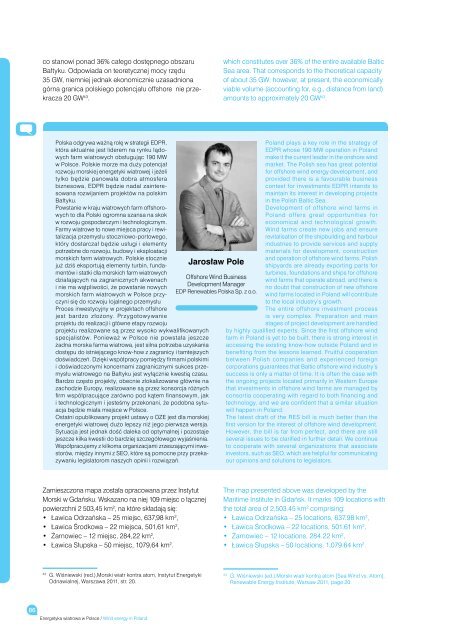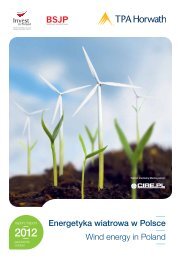Energetyka wiatrowa w Polsce Wind energy in Poland - TPA Horwath
Energetyka wiatrowa w Polsce Wind energy in Poland - TPA Horwath
Energetyka wiatrowa w Polsce Wind energy in Poland - TPA Horwath
You also want an ePaper? Increase the reach of your titles
YUMPU automatically turns print PDFs into web optimized ePapers that Google loves.
86<br />
co stanowi ponad 36% całego dostępnego obszaru<br />
Bałtyku. Odpowiada on teoretycznej mocy rzędu<br />
35 GW, niemniej jednak ekonomicznie uzasadniona<br />
górna granica polskiego potencjału offshore nie przekracza<br />
20 GW 43 .<br />
Polska odgrywa ważną rolę w strategii EDPR,<br />
która aktualnie jest liderem na rynku lądowych<br />
farm wiatrowych obsługując 190 MW<br />
w <strong>Polsce</strong>. Polskie morze ma duży potencjał<br />
rozwoju morskiej energetyki wiatrowej i jeżeli<br />
tylko będzie panowała dobra atmosfera<br />
biznesowa, EDPR będzie nadal za<strong>in</strong>teresowana<br />
rozwijaniem projektów na polskim<br />
Bałtyku.<br />
Powstanie w kraju wiatrowych farm offshorowych<br />
to dla Polski ogromna szansa na skok<br />
w rozwoju gospodarczym i technologicznym.<br />
Farmy wiatrowe to nowe miejsca pracy i rewitalizacja<br />
przemysłu stoczniowo-portowego,<br />
który dostarczał będzie usługi i elementy<br />
potrzebne do rozwoju, budowy i eksploatacji<br />
morskich farm wiatrowych. Polskie stocznie<br />
już dziś eksportują elementy turb<strong>in</strong>, fundamentów<br />
i statki dla morskich farm wiatrowych<br />
działających na zagranicznych akwenach<br />
i nie ma wątpliwości, że powstanie nowych<br />
morskich farm wiatrowych w <strong>Polsce</strong> przyczyni<br />
się do rozwoju lojalnego przemysłu<br />
Proces <strong>in</strong>westycyjny w projektach offshore<br />
jest bardzo złożony. Przygotowywanie<br />
projektu do realizacji i główne etapy rozwoju<br />
projektu realizowane są przez wysoko wykwalifikowanych<br />
specjalistów. Ponieważ w <strong>Polsce</strong> nie powstała jeszcze<br />
żadna morska farma <strong>wiatrowa</strong>, jest silna potrzeba uzyskania<br />
dostępu do istniejącego know-how z zagranicy i tamtejszych<br />
doświadczeń. Dzięki współpracy pomiędzy firmami polskimi<br />
i doświadczonymi koncernami zagranicznymi sukces przemysłu<br />
wiatrowego na Bałtyku jest wyłącznie kwestią czasu.<br />
Bardzo często projekty, obecnie zlokalizowane głównie na<br />
zachodzie Europy, realizowane są przez konsorcja różnych<br />
firm współpracujące zarówno pod kątem f<strong>in</strong>ansowym, jak<br />
i technologicznym i jesteśmy przekonani, że podobna sytuacja<br />
będzie miała miejsce w <strong>Polsce</strong>.<br />
Ostatni opublikowany projekt ustawy o OZE jest dla morskiej<br />
energetyki wiatrowej dużo lepszy niż jego pierwsza wersja.<br />
Sytuacja jest jednak dość daleka od optymalnej i pozostaje<br />
jeszcze kilka kwestii do bardziej szczegółowego wyjaśnienia.<br />
Współpracujemy z kilkoma organizacjami zrzeszającymi <strong>in</strong>westorów,<br />
między <strong>in</strong>nymi z SEO, które są pomocne przy przekazywaniu<br />
legislatorom naszych op<strong>in</strong>ii i rozwiązań.<br />
Zamieszczona mapa została opracowana przez Instytut<br />
Morski w Gdańsku. Wskazano na niej 109 miejsc o łącznej<br />
powierzchni 2 503,45 km 2 , na które składają się:<br />
• Ławica Odrzańska – 25 miejsc, 637,98 km 2 ,<br />
• Ławica Środkowa – 22 miejsca, 501,61 km 2 ,<br />
• Żarnowiec – 12 miejsc, 284,22 km 2 ,<br />
• Ławica Słupska – 50 miejsc, 1079,64 km 2 .<br />
43 G. Wiśniewski (red.),Morski wiatr kontra atom, Instytut Energetyki<br />
Odnawialnej, Warszawa 2011, str. 20.<br />
<strong>Energetyka</strong> <strong>wiatrowa</strong> w <strong>Polsce</strong> / <strong>W<strong>in</strong>d</strong> <strong>energy</strong> <strong>in</strong> <strong>Poland</strong><br />
Jarosław Pole<br />
Offshore <strong>W<strong>in</strong>d</strong> Bus<strong>in</strong>ess<br />
Development Manager<br />
EDP Renewables Polska Sp. z o.o.<br />
which constitutes over 36% of the entire available Baltic<br />
Sea area. That corresponds to the theoretical capacity<br />
of about 35 GW; however, at present, the economically<br />
viable volume (account<strong>in</strong>g for, e.g., distance from land)<br />
amounts to approximately 20 GW 43 .<br />
<strong>Poland</strong> plays a key role <strong>in</strong> the strategy of<br />
EDPR whose 190 MW operation <strong>in</strong> <strong>Poland</strong><br />
make it the current leader <strong>in</strong> the onshore w<strong>in</strong>d<br />
market. The Polish sea has great potential<br />
for offshore w<strong>in</strong>d <strong>energy</strong> development, and<br />
provided there is a favourable bus<strong>in</strong>ess<br />
context for <strong>in</strong>vestments EDPR <strong>in</strong>tends to<br />
ma<strong>in</strong>ta<strong>in</strong> its <strong>in</strong>terest <strong>in</strong> develop<strong>in</strong>g projects<br />
<strong>in</strong> the Polish Baltic Sea.<br />
Development of offshore w<strong>in</strong>d farms <strong>in</strong><br />
<strong>Poland</strong> offers great opportunities for<br />
economical and technological growth.<br />
<strong>W<strong>in</strong>d</strong> farms create new jobs and ensure<br />
revitalisation of the shipbuild<strong>in</strong>g and harbour<br />
<strong>in</strong>dustries to provide services and supply<br />
materials for development, construction<br />
and operation of offshore w<strong>in</strong>d farms. Polish<br />
shipyards are already export<strong>in</strong>g parts for<br />
turb<strong>in</strong>es, foundations and ships for offshore<br />
w<strong>in</strong>d farms that operate abroad, and there is<br />
no doubt that construction of new offshore<br />
w<strong>in</strong>d farms located <strong>in</strong> <strong>Poland</strong> will contribute<br />
to the local <strong>in</strong>dustry’s growth.<br />
The entire offshore <strong>in</strong>vestment process<br />
is very complex. Preparation and ma<strong>in</strong><br />
stages of project development are handled<br />
by highly qualified experts. S<strong>in</strong>ce the first offshore w<strong>in</strong>d<br />
farm <strong>in</strong> <strong>Poland</strong> is yet to be built, there is strong <strong>in</strong>terest <strong>in</strong><br />
access<strong>in</strong>g the exist<strong>in</strong>g know-how outside <strong>Poland</strong> and <strong>in</strong><br />
benefit<strong>in</strong>g from the lessons learned. Fruitful cooperation<br />
between Polish companies and experienced foreign<br />
corporations guarantees that Baltic offshore w<strong>in</strong>d <strong>in</strong>dustry’s<br />
success is only a matter of time. It is often the case with<br />
the ongo<strong>in</strong>g projects located primarily <strong>in</strong> Western Europe<br />
that <strong>in</strong>vestments <strong>in</strong> offshore w<strong>in</strong>d farms are managed by<br />
consortia cooperat<strong>in</strong>g with regard to both f<strong>in</strong>anc<strong>in</strong>g and<br />
technology, and we are confident that a similar situation<br />
will happen <strong>in</strong> <strong>Poland</strong>.<br />
The latest draft of the RES bill is much better than the<br />
first version for the <strong>in</strong>terest of offshore w<strong>in</strong>d development.<br />
However, the bill is far from perfect, and there are still<br />
several issues to be clarified <strong>in</strong> further detail. We cont<strong>in</strong>ue<br />
to cooperate with several organizations that associate<br />
<strong>in</strong>vestors, such as SEO, which are helpful for communicat<strong>in</strong>g<br />
our op<strong>in</strong>ions and solutions to legislators.<br />
The map presented above was developed by the<br />
Maritime Institute <strong>in</strong> Gdańsk. It marks 109 locations with<br />
the total area of 2,503.45 km 2 compris<strong>in</strong>g:<br />
• Ławica Odrzańska – 25 locations, 637.98 km 2 ,<br />
• Ławica Środkowa – 22 locations, 501.61 km 2 ,<br />
• Żarnowiec – 12 locations, 284.22 km 2 ,<br />
• Ławica Słupska – 50 locations, 1,079.64 km 2 .<br />
43 G. Wiśniewski (ed.),Morski wiatr kontra atom [Sea <strong>W<strong>in</strong>d</strong> vs. Atom],<br />
Renewable Energy Institute, Warsaw 2011, page 20.



